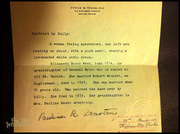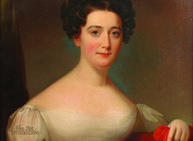
A signed and notarized letter dictated by the subject’s granddaughter had been passed down through a family. It began, “Portrait by Sully.” But a Christie’s appraiser and staff at two different Manhattan, New York, galleries said Thomas Sully (1783-1872) was not the artist. They offered no suggestions as to who the artist could be. Without the name of an artist, the portrait’s owner knew the value was questionable. The owner of Elizabeth A. Brooke Weed (Mrs. Robert J. Arundel), contacted Fine Art Investigations for help.
The Clue
The painting was obviously not by Sully. It lacked the long neck and arms, the theatrical style, and the facile brushwork that give his work the Sully “look.” But if not Sully, then who? Fine Art Investigations learned that when the portrait subject’s granddaughter dictated the note[1] in 1944, she was 85 years old. Surely her intentions were good, but she not only gave the wrong name for the artist, she gave the wrong birth, marriage, and death dates for her family. The names were correct, though, and those clues were enough.

Portrait by Sully:
A woman facing spectators, her left arm resting on chair, with a pink scarf, wearing a low-necked white satin dress.
Elizabeth Brook Weed, born 1814, the granddaughter of General Brook who is buried at Old St. David’s. She married Robert Arundel, an Englishman, born in 1802. She was married when she was 21 years old. Was painted the same year by Sully. She died in 1879. Her granddaughter is Mrs. Pauline Rambo Armstrong.
Pauline R. Armstrong (signed)
Notarized 28th November 1944 by William M. Parks))
The Artist
The subject’s dress and hairstyle indicated a date of execution in the mid-1820s. Public records showed Elizabeth Weed’s marriage to Robert James Arundel took place in Philadelphia, Pennsylvania on March 25, 1828. Connoisseurship suggested that the artist was Jacob Eichholtz (1776-1842), a friend and colleague of Thomas Sully. Especially persuasive was the image of Jane Evans Tevis, 1827, at the Smithsonian American Art Museum. Other examples:

Jacob Eichholtz, Portrait of a Woman, ND Private Collection 
Jacob Eichholtz, Elizabeth A. Brooke Weed (Mrs. Robert J. Arundel), ca. 1828 Oil on Canvas, 30 x 25 inches Private Collection 
Jacob Eichholtz, Mrs. Lawrence Lewis, 1825 Private Collection
The next step was to check the Eichholtz Catalogue Raisonné, Jacob Eichholtz, 1776-1842, Portrait Painter of Pennsylvania, by Rebecca Beal, published in 1969. Beal organized Eichholtz’s portraits alphabetically. Robert J. Arundel and Mrs. Arundel were #12 and #13. Each was dated 1825. Only Robert J. Arundel was pictured. His portrait was a fine companion piece to Elizabeth Arundel. But there were two problems: the description and provenance for Mrs. Arundel.((Rebecca J. Beal, Jacob Eichholtz (1776-1842): Portrait Painter of Pennsylvania, (Philadelphia, The Historical Society of Pennsylvania, 1964), 6))

Elizabeth Brooke Weed (Mrs. Robert James Arundel) 
Jacob Eichholtz (1776-1842), Robert James Arundel, ca.1828
Private Collection
Different Description
Beal’s description for the portrait, Mrs. Arundel, was:
Young woman seated, facing right, head to front, chestnut-brown hair, white cap; black dress with white lace at neck, India shawl; reddish brown curtain and landscape in background.
White cap? Black dress with white lace at neck? No, this Mrs. Arundel wore a white dress and a red shawl. No cap. No collar.
Different Provenance
According to Beal, when both portraits were exhibited at the Panama Pacific International Exposition in San Francisco in 1915, they were lent by Philadelphia art collector Albert Rosenthal. Provenance for the portrait in Manhattan carried through two families, none of whom were named Rosenthal. With these differences, what should have been a relatively simple artist identification turned complicated.
Untwining the Two Mrs. Arundels
Could Jacob Eichholtz have painted more than one portrait of the same woman? The Smithsonian’s Inventory of American Paintings listed two portraits of Elizabeth Arundel’s husband: Mr. Arundel and Mr. Robert J. Arundel, Did Eichholtz paint the Arundels twice? Beal wrote of Eichholtz, “He is known to have painted more than one portrait of the same subject.((Beal. xi))” In a sampling of the eight years between 1805 and 1813 in the Catalogue Raisonné, Eichholtz painted portraits of seven individuals twice.((Benjamin Schaum, c. 1808, c. 1810; Mrs. Benjamin Schaum, c. 1808, c. 1810; Nicholas Biddle, 1811 (twice);Robert Coleman, c. 1812 (twice); Rev. Gotthill Henry Ernest Muhlenberg, 1811 (twice), Jacob Leman, 1805. 1813; Mrs. Jacob Leman, 1805, c. 1813.)) To learn if there were two pairs of portraits for Mr. and Mrs. Arundel, I needed more information.
Beal’s source for the Arundel portraits was a copy of the 1915 Panama Pacific International Exposition catalogue. I located a copy. The portraits were simply listed without description or illustration.
Librarian to the Rescue
Like all researchers, I depend on librarians. Sherry Hartline, at the Timberland Regional Library in Ilwaco, Washington, found a 1920 booklet, Illustrated catalogue of the remarkable and widely known collection of early American and British portraits, landscapes and historical pictures formed by the connoisseur, the late Frank Bulkeley Smith of Worcester, Massachusetts. In it were black and white images and descriptions.The complete description for Mrs. Arundel was:
Three-quarter length, to left; a middle-aged woman of agreeable expression, with chestnut brown hair parted smoothly over the forehead, curled beside the temples, and enwound in a white kerchief or turban-like cap. She is in black, with puffed sleeves, and a deep ruffle of white lace about her neck. Over her arm and lap an India shawl. Background of reddish-brown curtain and conventional landscape.
Exhibited at the Panama-Pacific Exhibition, San Francisco, 1915((American Art Association, Frank Bulkeley Smith, Illustrated catalogue of the remarkable and widely known collection of early American and British portraits, landscapes and historical pictures formed by the connoisseur, the late Frank Bulkeley Smith of Worcester, Massachusetts, (Lent & Graff Co., 192), 125-128.))
The accompanying image:

from the Illustrated catalogue of the remarkable and widely known collection of early American and British portraits from the collection of the late Frank Bulkeley Smith, Worcester, Massachusetts
Who was she?
M. S. Arundel
The clue was in the complete title of the portrait of Mr. Arundel in the same catalogue:

All other records based on this original entry omitted, “Son of M. S. Arundel.” Earlier, in studying genealogical records during provenance research, I had learned that Robert James Arundel (1802/1810 -1868) was the son of Sailing Captain Robert Arundel (1744-1812), born in England, and Margaret Jack (1776-1836) of Pennsylvania.
During the War of 1812, Captain Robert Arundel commanded the American schooner Pert. On November 9, 1812, at the Battle of Kingston Harbor on the Great Lakes, a cannon exploded aboard the Pert. Captain Arundel was wounded, but refused to leave the deck. Struck by the boom, he was thrown overboard and drowned – a British-born American hero. Captain Robert Arundel was not “M. S. Arundel.” “M. S. Arundel” had to refer to Robert Arundel’s mother, Margaret Jack Arundel. In the script of the time a “J” for Jack could be misread as “S”. Eichholtz did not paint Mrs. Arundel twice. He painted two Mrs. Arundels: Mrs. Robert Arundel, Sr. and Mrs. Robert Arundel, Jr.
The image of Mr. Arundel in the 1920 Frank Bulkeley Smith sales catalogue was identical to the image of Robert J. Arundel in Beal’s 1969 Catalogue Raisonné. To be absolutely certain I was dealing with only one Robert Arundel, I sent for the Parke-Bernet catalogue from 1960, the source for one of two entries for Mr. Arundel in the Smithsonian’s Inventory.((Parke-Bernet Galleries, Inc., French, Italian & English Furniture, Silver & Silver plated Ware, Paintings and Drawings, Tapestries, Textiles & Oriental Rugs from the Estates of the Late Lillian S. Timken, New York, sold by order of the Legatees, Julie Parsons Redmond, New York, sold by order of the Executor and other sources, Public Auction Sale, Friday and Saturday, May 13 and 14 at 1:45 p.m., (New York, 1960), 45 (216).)) Within it, I found the same image and an extension of the same provenance. The entry confirmed that Jacob Eichholtz painted only one portrait of Mr. Robert James Arundel. All the evidence indicated that the portrait, Elizabeth A. Brook Weed (Mrs. Robert James Arundel) was a previously unknown third in what was a trio of portraits Jacob Eichholtz painted in Philadelphia in 1828 of a groom, his bride, and his mother.

Jacob Eichholtz (1776-1842), Robert James Arundel, ca.1828
Private Collection
Jacob Eichholtz, Elizabeth A. Brooke Weed (Mrs. Robert J. Arundel), ca. 1828
Oil on Canvas, 30 x 25 inches Private Collection
Jacob Eichholtz, Margaret Jack (Mrs. Robert Arundel, Sr.), ca. 1828
Oil on Canvas Private Collection
Conclusion
What remained was verification of the attribution with an acknowledged Eichholtz expert. After reviewing my research, that person((Prefers name not be published.)) replied, “I concur with your conclusion regarding attribution. You made a very compelling case that would be hard for anyone to argue with based on the information and comparables.”
The owner of the Jacob Eichholtz painting, Elizabeth Ann Brook Weed (Mrs. Robert James Arundel), ca. 1828, placed the portrait for sale at auction. As a portrait by Jacob Eichholtz, the painting fetched a respectable price.

